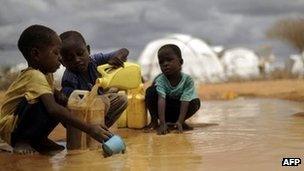Rains ease Somali drought
- Published
- comments

Hundreds of thousands are sheltering in refugee camps in Kenya after fleeing the famine in Somalia
The long drought has lifted in southern and central Somalia, with fairly good rains now falling across much of those regions gripped by famine.
The rain brings some risks. There's particular concern among aid workers about communicable diseases like cholera spreading, above all in the crowded camps in Mogadishu.
Measles is perhaps the biggest threat, although that has less to do with the rains and more to do with the Islamist group al-Shabab's obstruction of mass vaccinations.
Aid deliveries could also get bogged down on the region's notoriously bad roads - although I hear that's not yet a major problem.
But the rain also means it is planting time - a critical period for those families that have not yet abandoned their homes, and for all those fighting to ensure that as many people as possible are able to stay in their communities.
Over the past few days I've been speaking in the aid "hub" of Nairobi to a number of senior officials involved in famine relief inside Somalia. Many have spent years - if not decades - working in the region.
Below I thought I would try to sum up some key points.
Most of the conversations were "off the record". It can sometimes be hard to separate humanitarian work from politics in an environment as complex as Somalia and many involved are cautious about public statements.
Everyone is concerned about the coming months. But the predictions range from "nightmarish" to - and I know it sounds callous taken out of context - "people will keep dying, but overall, we're not too worried about the situation".
The aid operation is "well funded until the end of the year" - but after that "it's a worry".
The dominant player in food deliveries - the World Food Programme - is still not able to access the worst regions, all controlled by al-Shabab. However others agencies are working to fill that gap and the ICRC maintains it is reaching all areas under al-Shabab control. It has already helped more than a million people and distributed 17,000 metric tons of food and seeds. One official said the ICRC was doing "an outstanding job" but others point out that Somalia's needs are still not close to being met, with four million people requiring urgent food aid.
Despite some "alarmism" from a handful of aid agencies, Kenya's military incursion has not yet had a significant impact on the humanitarian situation inside Somalia. The concern though, is that an escalation in fighting could yet lead more families to flee rather than planting crops.
An expected military offensive against al-Shabab forces to the south of Mogadishu - in the Afgooye corridor - could lead to a big new influx into the capital's already overcrowded camps and threatens those already seeking refuge in Afgooye. One local agency, SAACID, has already seen the number of cases of malnourished children in Mogadishu rise by a third in the past two months.
There are "signs of stabilisation" in the local economy in famine areas. Inflation of about 270% was a key factor triggering the famine but about 40% of aid is currently in the form of cash or food vouchers - a fact that often gets overlooked. The vouchers and money don't seem to have driven up inflation further, as some had feared, but instead are helping to shore up local markets and allow traders to play an important role in fighting the famine.
Al-Shabab bureaucracy and obstructionism remain a problem for aid organisations. But similar problems exist within the UN-backed government. There are reports that many senior al-Shabab officials have been sent to fight the Kenyans, leaving more junior people in charge of aid coordination efforts.
A key goal of the aid effort is to keep people in their homes. If they move to camps for more than six months, they are statistically very unlikely ever to return to their communities. That makes this planting season enormously important.
This is a long-term problem - and most people involved are profoundly frustrated by the lack of long-term funding for the sort of programmes that might help Somalis better to withstand the next drought.